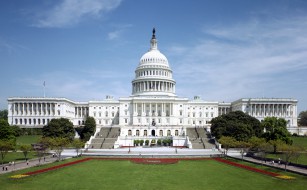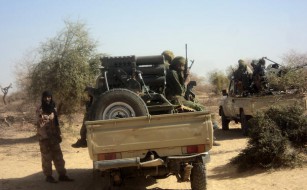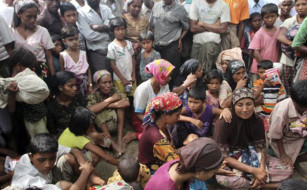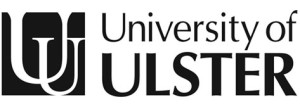Forest Nativity: Amazon Fires, State-Corporate Crime, Vulnerability
![holding image - Bebey Forest Nativity[1]](http://statecrime.org/data/2019/08/holding-image-Bebey-Forest-Nativity1-475x380.png)
Rimona Afana
Visiting Scholar, Vulnerability Initiative, Emory School of Law
Listening to Francis Bebey’s ‘Forest Nativity’ awakens my senses to the lush, pristine, cryptic rainforest. David Attenborough’s tales of the rainforest’s bizarre tiny denizens color my perception of sound. Now, the song instead warns me of smoke and ashes, greed and impunity.
The Amazon is burning. Smoke from the blaze is enveloping nearby cities and can be seen from space. Since the beginning of this year, over 76,000 fires[1] have been documented in Brazil, most of them in the world’s largest rainforest. Amazon Watch notes in a recent report that the “ascension of the extreme right-wing politician Jair Bolsonaro to Brazil’s presidency profoundly exacerbates the country’s environmental and human rights crisis.”[2] Companies operating in the Amazon – linked to illegal deforestation, corruption, slave labor, and other crimes – trading with European and North American partners, are aided and abetted by the Bolsonaro regime, its cabinet members “serving as political operatives for the country’s agribusiness and mining sectors.”[3] The ongoing ecocide in the Amazon is driven by deforestation, often followed by fires to clear areas for agriculture; environmentalists attribute slash-and-burn tactics to cattle ranchers and loggers, emboldened by the state’s pro-business agenda and recklessness on environmental issues.[4] Within one year deforestation caused the loss of an area equivalent to nearly one million football pitches.[5] This environmental catastrophe – destroying rainforest ecosystems, debilitating indigenous communities, and contributing to climate change – seems to be the result of systematic state-corporate crime[6].
The tragedy in the Amazon is not unique: this month forests and grassland have gone ablaze in Siberia, Alaska, Greenland, the Canary Islands, California, Angola, DR Congo, and in other parts of the world[7], driven by record heat, drought, and deforestation. Thousands of monitoring stations attest that July 2019 was the hottest month on earth since at least 1850 and by the end of the month 1 million square miles of ice at the Arctic and Antarctic had melted.[8] Only between 1-14 August 2019, Arctic sea ice had declined at a daily rate of 35,000 square miles.[9] Over half of the Great Barrier Reef, the earth’s largest living organism, is already dead because of heat and acidity caused by human activity, leading to a rippling ecosystem collapse in the ocean, with devastating effects on the entire planet.[10] Confronting the terrifying evidence of the climate crisis leaves leading climate change scientists weeping behind closed doors.[11]
Massive deforestation operations globally are clearing space for cropland and pastures, both to feed the livestock we breed to then slaughter. Animal agriculture contributes to the global ecological crisis through its major role in climate change and air pollution, in water depletion and pollution, alongside its impact on biodiversity loss.[12] Almost a decade ago the United Nations Environment Programme cautioned that a reduction in this devastating environmental footprint “would only be possible with a substantial worldwide diet change, away from animal products.”[13] The Intergovernmental Panel on Climate Change concurs that, since climate change is projected to negatively impact global food security, plant-based diets are significant, given their low environmental impact.[14] Recent research substantiates this transformative potential: excluding animal products would reduce by 76% the land we currently use for food.[15] That land could be dedicated to restoring and revitalizing ecosystems now compromised, which gradually would reduce the risk of ecological collapse. Besides concerns about animal cruelty and on the potentially detrimental health effects of eating meat, awareness of the calamitous environmental impact of animal farming is one of the main drivers of veganism, now one of the fastest growing movements in the world.[16]
The history of sexism and racism shows that the justifications used to render certain lives inferior (and thus suited for subjugation) are strikingly similar to how carnism[17] and speciesism[18] continue to operate: through denial, strategic invisibilities, and discrimination which legitimate physical, structural, and epistemic violence. Given the significant progress in recent decades on sexism and racism, scholarship and activism may gradually treat speciesism also as a transgression of individual and collective rights. These aspects have driven scholarly debates on whether nonhuman animals could be seen as persons[19], as well as groundbreaking initiatives giving nature legal personhood.[20] The inevitable interdependence between different forms of life is increasingly recognized.
What can a vulnerability lens contribute here? Vulnerability theory[21] reminds us that vulnerability is not exceptional, but universal and constant. Vulnerability stems from our human condition: embodied (our existence depends on a fragile material case, the body) and embedded (we are never autonomous but depend on others in complex ways). Prof. Martha Fineman’s jurisprudence replaces the independent, self-sufficient liberal legal subject with the “vulnerable subject”. Within this approach, the opposite of vulnerability is not invulnerability but resilience – the capacity to withstand harm. Vulnerability theory shows that resilience is the responsibility of law and of institutions (‘the responsive state”) which are meant, ideally, to mitigate our inherent vulnerability. I believe the Amazon fires and surrounding debates on ecology, speciesism, and state-corporate crime can be critically revisited through vulnerability theory’s insistence on dependency and interdependence. Given our biological and social reliance on other lives to sustain our own, the destruction of ecosystems carries immediate and multigenerational effects on humans, flora, fauna, and other life forms. Ecosystem collapse makes us all less resilient. The failure of Brazilian authorities and of the international community to protect nature puts a lasting dent in Forest Nativity[22], literally and figuratively, and in our ability to cope with common, intersecting vulnerabilities.
[1] Instituto Nacional De Pesquisas Espaciais Brasil (2019). Portal do Programa Queimadas do INPE: Situação atual. http://queimadas.dgi.inpe.br/queimadas/portal/situacao-atual
[2] Amazon Watch (2019). Complicity in destruction II: How northern consumers and financiers enable Bolsonaro’s assault on the Brazilian Amazon (p. 3). Washington, DC: Amazon Watch. https://amazonwatch.org/assets/files/2019-complicity-in-destruction-2.pdf?
[3] Ibid., p. 5.
[4] Democracy Now (2019, August 23). How Jair Bolsonaro emboldened Brazilian agribusiness to torch the Amazon & attack indigenous people. https://www.democracynow.org/2019/8/23/andrew_miller_amazon_fires_jair_bolsonaro?
Yeung, J. (2019, August 23). Blame humans for starting the Amazon fires, environmentalists say. CNN. https://edition.cnn.com/2019/08/22/americas/amazon-fires-humans-intl-hnk-trnd/index.html
Hyde, J. (2019, August 23). Brazilian farmers believe they have the right to burn the Amazon. Rolling Stone. https://www.rollingstone.com/politics/politics-news/brazilian-farmers-believe-they-have-the-right-to-burn-the-amazon-875879/
Zaitchik, A. (2019, July 6). Rainforest on fire. The Intercept. https://theintercept.com/2019/07/06/brazil-amazon-rainforest-indigenous-conservation-agribusiness-ranching/
Barlow, J., & Lees, A. C. (2019, August 23). Amazon fires explained: What are they, why are they so damaging, and how can we stop them? The Conversation. https://theconversation.com/amazon-fires-explained-what-are-they-why-are-they-so-damaging-and-how-can-we-stop-them-122340
Libardi, M. (2019, August 21). Leaked documents show Brazil’s Bolsonaro has grave plans for Amazon rainforest. Democracy Now. https://www.opendemocracy.net/en/democraciaabierta/leaked-documents-show-brazil-bolsonaro-has-grave-plans-for-amazon-rainforest/
[5] Greenpeace (2018, November 23). Brazil: Deforestation in the Amazon reaches decade high. https://www.greenpeace.org/brasil/press/brazil-deforestation-in-the-amazon-reaches-decade-high/
[6] International State Crime Initiative (2014). A critical introduction to state-corporate crime. http://statecrime.org/state-crime-research/state-corporate-crime-crit-intro/
[7] Global Forest Watch Fires (2019). GFWF interactive map. https://fires.globalforestwatch.org/map
NASA Fire Information for Resource Management System (2019). FIRMS fire map. https://firms2.modaps.eosdis.nasa.gov/map
Irfan, U., & Amaria, K. (2019, August 22). Photos: Major wildfires have ignited across Europe, Asia, and Latin America. Vox. https://www.vox.com/2019/8/22/20828219/amazon-rainforest-wildfire-photos-fire-greenland
[8] Freedman, A. (2019, August 15). July was Earth’s hottest month since records began, with the globe missing 1 million square miles of sea ice. The Washington Post. https://www.washingtonpost.com/weather/2019/08/15/independent-data-confirms-july-was-earths-hottest-month-since-records-began/
[9] National Snow & Ice Data Center (2019). Arctic sea ice news & analysis: Overview of conditions. https://nsidc.org/arcticseaicenews/
[10] Loria, K. (2018, April 19). Half of the Great Barrier Reef has died since 2016 — here’s what happens if all coral reefs on Earth die off. Business Insider. https://www.businessinsider.com/coral-reefs-great-barrier-reef-dying-from-bleaching-warming-2018-4
Hughes, T. P. et al. (2019, April 18). Global warming impairs stock–recruitment dynamics of corals. Nature, 568, 387-390. https://www.nature.com/articles/s41586-019-1081-y.epdf?
[11] Gergis, J. (2019). The terrible truth of climate change. The Monthly. https://www.themonthly.com.au/issue/2019/august/1566136800/jo-lle-gergis/terrible-truth-climate-change?
[12] United Nations Food and Agriculture Organization (2006). Livestock’s long shadow: Environmental issues and options. Livestock, Environment and Development (LEAD) Initiative. Rome: FAO Publications branch. http://www.fao.org/3/a0701e/a0701e.pdf
[13] United Nations Environment Programme (2010). Assessing the environmental impacts of consumption and production: Priority products and materials (p. 82). Report of the Working Group on the Environmental Impacts of Products and Materials to the International Panel for Sustainable Resource Management. http://www.unep.fr/shared/publications/pdf/dtix1262xpa-priorityproductsandmaterials_report.pdf
[14] Intergovernmental Panel on Climate Change (2019). Climate change and land: An IPCC special report on climate change, desertification, land degradation, sustainable land management, food security, and greenhouse gas fluxes in terrestrial ecosystems (final government draft version, Chapter 5, p. 66 and 89). https://www.ipcc.ch/site/assets/uploads/2019/08/2f.-Chapter-5_FINAL.pdf
[15] Poore, J., & Nemecek, T. (2018). Reducing food’s environmental impacts through producers and consumers (p. 991). Science, 360(6392), 987-992. https://science.sciencemag.org/content/sci/360/6392/987.full.pdf
[16] Hancox, D. (2018, April 1). The unstoppable rise of veganism: how a fringe movement went mainstream. The Guardian. https://www.theguardian.com/lifeandstyle/2018/apr/01/vegans-are-coming-millennials-health-climate-change-animal-welfare
[17] Joy, M. (2015, December 16). The secret reason we eat meat [Video recording]. Beyond Carnism. https://www.youtube.com/watch?v=ao2GL3NAWQU
[18] Ryder, R. D. (2011). Speciesism, painism and happiness: A morality for the twenty-first century. Exeter: Imprint Academic.
Weitzenfeld, A., & Joy, M. (2014). An overview of anthropocentrism, humanism, and speciesism in critical animal theory. Counterpoints, 448, 3-27.
Animal Ethics (n.d.). Speciesism. https://www.animal-ethics.org/speciesism/
Ultraventus Films (2012). The superior human [Documentary film]. https://www.youtube.com/watch?v=mqT82oGeax0
[19] Tooley, M. (2011). Are nonhuman animals persons? In T. L. Beauchamp & R. G. Frey (Eds.), The Oxford Handbook of Animal Ethics (pp. 332-370). Oxford/New Work: Oxford University Press.
Satz, A. B. (2009). Animals as vulnerable subjects: Beyond interest-convergence, hierarchy, and property. Animal Law, 16(2), 65-122. https://www.animallaw.info/sites/default/files/lralvol16_p65.PDF
Weizman, E. (2016, October 10). Are they human? e-flux. https://www.e-flux.com/architecture/superhumanity/68645/are-they-human/
[20] Keim, B. (2014, December 22). An orangutan has (some) human rights, Argentine court rules. Wired. https://www.wired.com/2014/12/orangutan-personhood/
Safi, M. (2017, March 21). Ganges and Yamuna rivers granted same legal rights as human beings. The Guardian. https://www.theguardian.com/world/2017/mar/21/ganges-and-yamuna-rivers-granted-same-legal-rights-as-human-beings
Ainge Roy, E. (2017, March 16). New Zealand river granted same legal rights as human being. The Guardian. https://www.theguardian.com/world/2017/mar/16/new-zealand-river-granted-same-legal-rights-as-human-being
Flynn Mogensen, J. (2019). Environmentalism’s next frontier: Giving nature legal rights. Mother Jones. https://www.motherjones.com/environment/2019/07/a-new-wave-of-environmentalists-want-to-give-nature-legal-rights/
[21] Fineman, M. A. (2004). The autonomy myth: A theory of dependency. New York, NY: The New Press.
Fineman, M. A. (2008). The vulnerable subject: Anchoring equality in the human condition. Yale Journal of Law & Feminism, 20(1), 1-23. https://pdfs.semanticscholar.org/96b1/60a89992705480407a2fa61559b6d8573162.pdf
Fineman, M. A. (2010). The vulnerable subject and the responsive state. Emory Law Journal, 60(2), 251-276. https://papers.ssrn.com/sol3/papers.cfm?abstract_id=1694740
The University of British Columbia (2012). Martha Fineman – Vulnerability and the human condition: A different approach to equality [Video recording]. UBC Green College, Richard V. Ericson lecture series. https://www.youtube.com/watch?v=seC6hqnpkPU
[22] Daly, N. (2019, August 23). What the Amazon fires mean for wild animals. National Geographic. https://www.nationalgeographic.com/animals/2019/08/how-the-amazon-rainforest-wildfires-will-affect-wild-animals/
24th August 2019









































